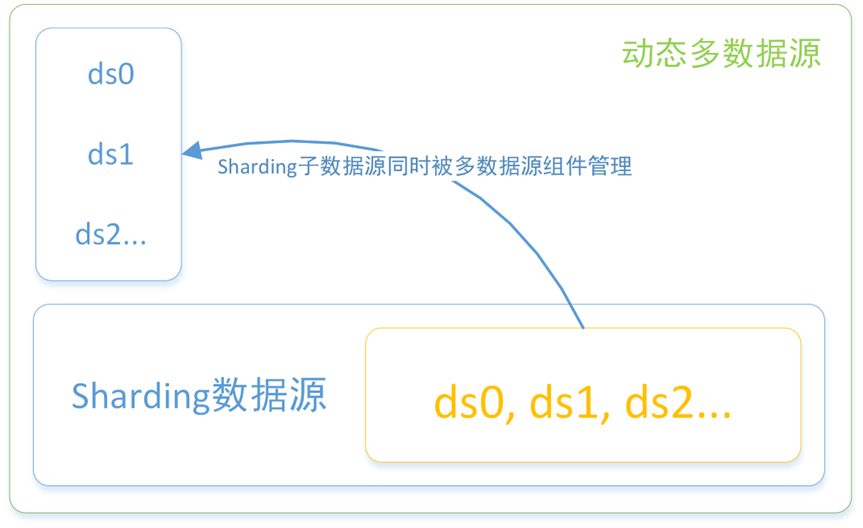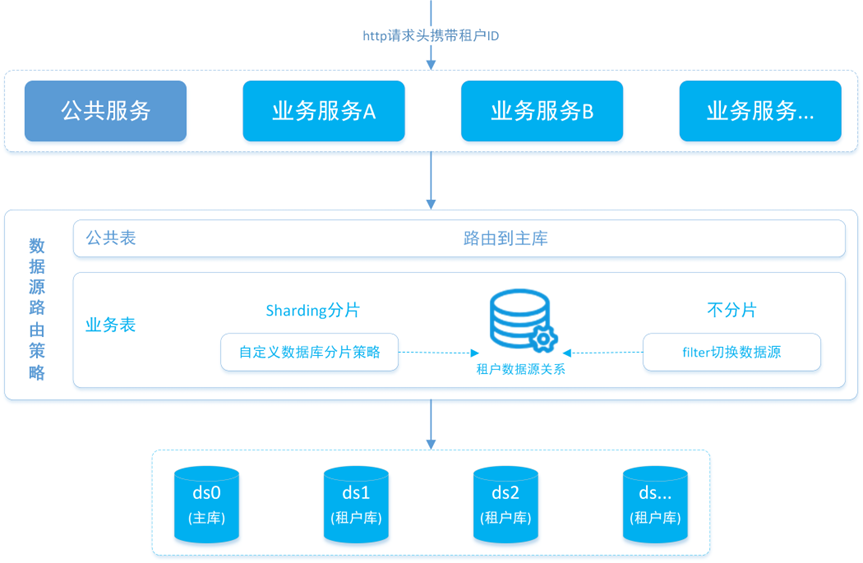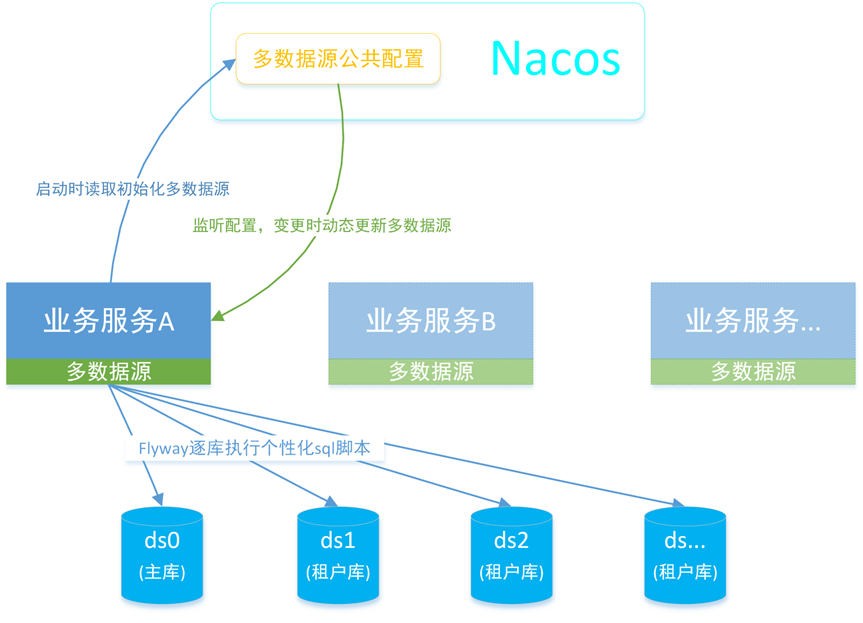首页 > 基础资料 博客日记
Mybatis-Plus集成Sharding-JDBC与Flyway实现多租户分库分表
2023-11-20 23:27:13基础资料围观687次
Java资料网推荐Mybatis-Plus集成Sharding-JDBC与Flyway实现多租户分库分表这篇文章给大家,欢迎收藏Java资料网享受知识的乐趣
背景
公司产品部收到了一些重要客户的需求,他们希望能够依赖独立的数据库存储来支持他们的业务数据。与此同时,仍有许多中小客户,可以继续使用公共库以满足其需求。技术实现方面,此前持久层框架使用的Mybatis-plus,部分业务场景使用到了Sharding-JDBC用于分表,另外,我们的数据库版本控制工具使用的是Flyway。
方案说明
这里将方案进行简要说明,配置统一通过Nacos管理(有需要的可以自行定义租户配置页面)。
- 1.首先多数据源管理使用Mybatis-Plus官方推荐的dynamic-datasource-spring-boot-starter组件,需要注意的是构建动态多数据源时,我们要把Sharding-JDBC数据源也纳入管理。因为我们的库里面毕竟只有部分表用到了Sharding-JDBC,这样可以复用数据源。

- 2.其次,租户与数据源之间在Nacos建立关系配置,确保根据租户ID能够路由到唯一的租户数据源。我们需要自定义Sharding分片策略和多数据源切换逻辑,根据http请求传入的租户ID,设置正确的数据源。

- 3.动态数据源与Sharding数据源配置做为公共配置在Nacos维护,在业务服务启动时,读取公共配置初始化多数据源,并添加对公共多数据源配置的监听。当配置变更时,重新构造Sharding数据源,并并更新动态多数据源。另外数据库脚本通过自定义flyway配置执行。

技术实现
前提
需要在Nacos提前维护租户与数据源关系配置。
不使用Sharding-JDBC场景
- 1.引入相关组件依赖。
<dependency>
<groupId>com.alibaba.nacos</groupId>
<artifactId>nacos-client</artifactId>
<version>2.1.0</version>
</dependency>
<dependency>
<groupId>org.flywaydb</groupId>
<artifactId>flyway-core</artifactId>
<version>7.15.0</version>
</dependency>
<dependency>
<groupId>com.baomidou</groupId>
<artifactId>mybatis-plus-boot-starter</artifactId>
<version>3.4.1</version>
</dependency>
<dependency>
<groupId>com.baomidou</groupId>
<artifactId>dynamic-datasource-spring-boot-starter</artifactId>
<version>3.4.1</version>
</dependency>
<dependency>
<groupId>com.alibaba</groupId>
<artifactId>druid</artifactId>
<version>1.2.6</version>
</dependency>
- 2.关闭Flyway自动配置和配置多数据源。
spring:
flyway:
#关闭flyway自动配置,自定义实现
enabled: false
datasource:
dynamic:
#默认数据源
primary: ds0
datasource:
ds0:
type: com.alibaba.druid.pool.DruidDataSource
driverClassName: org.postgresql.Driver
url: jdbc:postgresql://127.0.0.1:5432/ds0
username: ds0
password: ds0123
ds1:
type: com.alibaba.druid.pool.DruidDataSource
driverClassName: org.postgresql.Driver
url: jdbc:postgresql://127.0.0.1:5432/ds1
username: ds1
password: ds1123
- 3.自定义实现Flyway配置类,对应的flyway脚本目录结构见下图,主库和租户库SQL脚本独立维护。
Java
@Slf4j
@Configuration
@EnableTransactionManagement
public class FlywayConfig {
@Value("${spring.application.name}")
private String appName;
@Autowired
private DataSource dataSource;
@Bean
public void migrate() {
log.info("flyway开始逐数据源执行脚本");
DynamicRoutingDataSource ds = (DynamicRoutingDataSource) dataSource;
Map<String, DataSource> dataSources = ds.getDataSources();
dataSources.forEach((k, v) -> {
if (!"sharding".equals(k)) {
// Flyway相关参数建议通过配置管理,以下代码仅供参考
Flyway flyway = Flyway.configure()
.dataSource(v)
.table("t_" + k + "_" + appName + "_version")
.baselineOnMigrate(true)
.outOfOrder(true)
.baselineVersion("1.0.0")
.baselineDescription(k + "初始化")
.locations(CommonConstant.SQL_BASE_LOCATION + (CommonConstant.DEFAULT_DS_NAME.equals(k) ? CommonConstant.MASTER_DB : CommonConstant.TENANT_DB))
.load();
flyway.migrate();
log.info("flyway在 {} 数据源执行脚本成功", k);
}
});
}
}

- 4.自定义实现数据源切换Filter类。
@Slf4j
@Component
@WebFilter(filterName = "dynamicDatasourceFilter", urlPatterns = {"/*"})
public class DynamicDatasourceFilter implements Filter {
// 构建演示用租户与数据源关系配置
private static Map<String, String> tenantDsMap = new HashMap<>();
static {
tenantDsMap.put("tenant123", "ds0");
tenantDsMap.put("tenant456", "ds0");
tenantDsMap.put("tenant789", "ds1");
}
@Override
public void doFilter(ServletRequest request, ServletResponse response, FilterChain chain) throws IOException, ServletException {
HttpServletRequest httpRequest = (HttpServletRequest) request;
// 从请求头获取租户ID
String tenantId = httpRequest.getHeader(CommonConstant.TENANT_HEADER);
try {
// 设置数据源
if (tenantDsMap.get(tenantId) == null) {
// 如果根据租户ID未找到租户数据源配置,默认走主库
DynamicDataSourceContextHolder.push(CommonConstant.DEFAULT_DS_NAME);
} else {
//注意,如果是分片表,那么需要在分片表Service类或方法上加@DS("sharding")注解,最终由sharding的库分片策略决定SQL在哪个库执行。而这里的设置将会被@DS注解配置覆盖
DynamicDataSourceContextHolder.push(tenantDsMap.get(tenantId));
}
// 执行
chain.doFilter(request, response);
} catch (Exception e) {
log.error("切换数据源失败,tenantId={},请求接口uri={},异常原因:{}", tenantId, httpRequest.getRequestURI(), ExceptionUtils.getStackTrace(e));
} finally {
// 清空当前线程数据源
DynamicDataSourceContextHolder.poll();
}
}

使用Sharding-JDBC
如果微服务还需要使用Sharding分片,那么还需要引入sharding-jdbc组件依赖,并配置sharding数据源和分片规则。如果是多个服务共用数据库,那么建议将Sharding数据源配置做为公共配置在Nacos管理,而Sharding分片规则则做为服务个性化配置单独维护(分片规则基本不需要动态变更),这样当有新租户需要申请开通独立租户库的时候,直接变更Sharding数据源公共配置,服务在监听到公共配置变更后,即可重新构建新的Sharding数据源实例和动态数据源更新,无需重启服务。
- 1.引入sharding-jdbc组件依赖。
<dependency>
<groupId>org.apache.shardingsphere</groupId>
<artifactId>sharding-jdbc-core</artifactId>
<version>4.1.1</version>
</dependency>
- 2.配置Sharding数据源和分片规则。
# sharding数据源配置
dataSources:
ds0: !!com.alibaba.druid.pool.DruidDataSource
driverClassName: org.postgresql.Driver
url: jdbc:postgresql://127.0.0.1:5432/ds0
username: ds0
password: ds0123
ds1: !!com.alibaba.druid.pool.DruidDataSource
driverClassName: org.postgresql.Driver
url: jdbc:postgresql://127.0.0.1:5432/ds1
username: ds1
password: ds1123
ds2: !!com.alibaba.druid.pool.DruidDataSource
driverClassName: org.postgresql.Driver
url: jdbc:postgresql://127.0.0.1:5432/ds2
username: ds2
password: ds2123
# sharding分片规则配置
shardingRule:
tables:
t_order:
actualDataNodes: ds$->{0..2}.t_order$->{0..1}
tableStrategy:
inline:
shardingColumn: order_no
algorithmExpression: t_order$->{order_no.toBigInteger() % 2}
defaultDataSourceName: ds0
# 默认库分片策略
defaultDatabaseStrategy:
standard:
shardingColumn: tenant_id
# 自定义精确分片策略
preciseAlgorithmClassName: cn.xtstu.demo.config.CustomDataSourcePreciseShardingAlgorithm
#hint:
#
# algorithmClassName: cn.xtstu.demo.config.CustomHintShardingAlgorithm
defaultTableStrategy:
none:
props:
sql.show: true
- 3.自定义精确分片策略。
public class CustomDataSourcePreciseShardingAlgorithm implements PreciseShardingAlgorithm<String> {
// 构建演示用租户与数据源关系配置
private static Map<String, String> tenantDsMap = new HashMap<>();
static {
tenantDsMap.put("tenant123", "ds0");
tenantDsMap.put("tenant456", "ds0");
tenantDsMap.put("tenant789", "ds1");
}
@Override
public String doSharding(Collection<String> dataSourceNames, PreciseShardingValue<String> shardingValue) {
// 库分片策略配置的分片键是字段tenant_id,根据分片键查询配置的数据源
String dsName = tenantDsMap.get(shardingValue.getValue());
// 如果如前文所属,Sharding子数据源key与dynamic数据源key保持一致的话,这里直接返回就行了
return dsName;
// TODO 需要处理未匹配到数据源的情况
}
}
- 4.自定义Hint分片策略(可选),适用于分片键与SQL无关的场景。
public class CustomHintShardingAlgorithm implements HintShardingAlgorithm<Integer> {
// 构建演示用租户与数据源关系配置
private static Map<String, String> tenantDsMap = new HashMap<>();
static {
tenantDsMap.put("tenant123", "ds0");
tenantDsMap.put("tenant456", "ds0");
tenantDsMap.put("tenant789", "ds1");
}
@Override
public Collection<String> doSharding(Collection<String> collection, HintShardingValue<Integer> hintShardingValue) {
Collection<String> result = new ArrayList<>();
// 从请求头取到当前租户ID
HttpServletRequest request = ((ServletRequestAttributes) RequestContextHolder.getRequestAttributes()).getRequest();
result.add(tenantDsMap.get(request.getHeader("tenantId")));
// TODO 需要处理未匹配到数据源的情况
return result;
}
}
- 5.自定义动态数据源配置(核心就是将sharding数据源及其子数据源添加到动态数据源一起管理)。
@Slf4j
@Configuration
public class CustomDynamicDataSourceConfig {
@Value("${spring.cloud.nacos.config.extension-configs[0].data-id}")
private String dataId;
@Value("${spring.cloud.nacos.config.group:DEFAULT_GROUP}")
private String group;
@Resource
private DynamicDataSourceProperties properties;
@Resource
private NacosHelper nacosHelper;
/**
* 启动时通过查询Nacos上sharding数据源及分片规则yaml配置初始化sharding-jdbc数据源
*
* @return
*/
@Bean
public ShardingDataSource shardingDataSource() {
ConfigService configService = nacosHelper.getConfigService();
if (configService == null) {
log.error("连接nacos失败");
}
String configInfo = null;
try {
configInfo = configService.getConfig(dataId, group, 5000);
} catch (NacosException e) {
log.error("获取{}配置失败,异常原因:{}", dataId, ExceptionUtils.getStackTrace(e));
}
if (StringUtils.isBlank(configInfo)) {
log.error("{}配置为空,启动失败", dataId);
throw new NullPointerException(dataId + "配置为空");
}
try {
// 通过工厂类和yaml配置创建Sharding数据源
return (ShardingDataSource) YamlShardingDataSourceFactory.createDataSource(configInfo.getBytes(StandardCharsets.UTF_8));
} catch (Exception e) {
log.error("创建sharding-jdbc数据源异常:{}", ExceptionUtils.getStackTrace(e));
throw new NullPointerException("sharding-jdbc数据源为空");
}
}
/**
* 将动态数据源设置为首选的
* 当spring存在多个数据源时, 自动注入的是首选的对象
* 设置为主要的数据源之后,就可以支持shardingJdbc原生的配置方式了
*/
@Primary
@Bean
public DataSource dataSource() {
DynamicRoutingDataSource dataSource = new DynamicRoutingDataSource();
dataSource.setPrimary(properties.getPrimary());
dataSource.setStrict(properties.getStrict());
dataSource.setStrategy(properties.getStrategy());
dataSource.setP6spy(properties.getP6spy());
dataSource.setSeata(properties.getSeata());
return dataSource;
}
/**
* 初始化动态数据源
*
* @return
*/
@Bean
public DynamicDataSourceProvider dynamicDataSourceProvider(ShardingDataSource shardingDataSource) {
return new AbstractDataSourceProvider() {
@Override
public Map<String, DataSource> loadDataSources() {
Map<String, DataSource> dataSourceMap = new HashMap<>();
// 将sharding数据源整体添加到动态数据源里
dataSourceMap.put(CommonConstant.SHARDING_DS_NAME, shardingDataSource);
// 同时把sharding内部管理的子数据源也添加到动态数据源里
Map<String, DataSource> shardingInnerDataSources = shardingDataSource.getDataSourceMap();
dataSourceMap.putAll(shardingInnerDataSources);
return dataSourceMap;
}
};
}
}
- 6.最后给出一份通过监听Nacos配置变更动态更新数据源的示例代码。注意:这份示例代码中只给出了Sharding配置变更时的处理逻辑,如果是dynamic数据源配置的话,有需要的可以参考着自行实现。
@Slf4j
@Configuration
public class NacosShardingConfigListener {
@Value("${spring.cloud.nacos.config.extension-configs[0].data-id}")
private String dataId;
@Value("${spring.cloud.nacos.config.group:DEFAULT_GROUP}")
private String group;
@Value("${spring.application.name}")
private String appName;
@Autowired
private DataSource dataSource;
@Autowired
private NacosHelper nacosHelper;
@PostConstruct
public void shardingConfigListener() throws Exception {
ConfigService configService = nacosHelper.getConfigService();
if (configService == null) {
return;
}
configService.addListener(dataId, group, new Listener() {
@Override
public Executor getExecutor() {
return null;
}
@Override
public void receiveConfigInfo(String configInfo) {
log.info("configInfo:\n{}", configInfo);
if (StringUtils.isBlank(configInfo)) {
log.warn("sharding-jdbc配置为空,不会刷新数据源");
return;
}
try {
if (StringUtils.isNotBlank(configInfo)) {
// 通过yaml配置创建sharding数据源(注意:如果分片规则是独立配置文件,那么需要提前合并数据源和分片规则配置)
ShardingDataSource shardingDataSource = (ShardingDataSource) YamlShardingDataSourceFactory.createDataSource(configInfo.getBytes(StandardCharsets.UTF_8));
Map<String, DataSource> shardingInnerDataSources = shardingDataSource.getDataSourceMap();
DynamicRoutingDataSource ds = (DynamicRoutingDataSource) dataSource;
// 遍历sharding子数据源
for (String poolName : shardingInnerDataSources.keySet()) {
// TODO 这里还有个细节,如果yaml配置删减了数据源,对应数据源应该要从ds中remove掉,且主数据源不能被remove。另外其实只有新增的数据源才需要执行flyway脚本
// 将sharding子数据源逐个添加到动态数据源
ds.addDataSource(poolName, shardingInnerDataSources.get(poolName));
// 通过代码完成数据源Flyway配置,并执行迁移操作
Flyway flyway = Flyway.configure()
.dataSource(dataSource)
.table("t_" + poolName + "_" + appName + "_version")
.baselineOnMigrate(true)
.outOfOrder(true)
.baselineVersion("1.0.0")
.baselineDescription(poolName + "初始化")
.locations(CommonConstant.SQL_BASE_LOCATION + CommonConstant.TENANT_DB)
.load();
flyway.migrate();
}
// 将sharding数据源自身也添加到动态数据源
ds.addDataSource(CommonConstant.SHARDING_DS_NAME, shardingDataSource);
log.info("动态数据源刷新完成,现有数据源:{}", JSONUtil.toJsonStr(ds.getDataSources().keySet()));
}
} catch (Exception e) {
log.error("创建sharding-jdbc数据源异常:{}", ExceptionUtils.getStackTrace(e));
}
}
});
}
}
文章来源:https://www.cnblogs.com/xfishup/p/17845187.html
本文来自互联网用户投稿,该文观点仅代表作者本人,不代表本站立场。本站仅提供信息存储空间服务,不拥有所有权,不承担相关法律责任。如若内容造成侵权/违法违规/事实不符,请联系邮箱:jacktools123@163.com进行投诉反馈,一经查实,立即删除!
本文来自互联网用户投稿,该文观点仅代表作者本人,不代表本站立场。本站仅提供信息存储空间服务,不拥有所有权,不承担相关法律责任。如若内容造成侵权/违法违规/事实不符,请联系邮箱:jacktools123@163.com进行投诉反馈,一经查实,立即删除!
标签:

